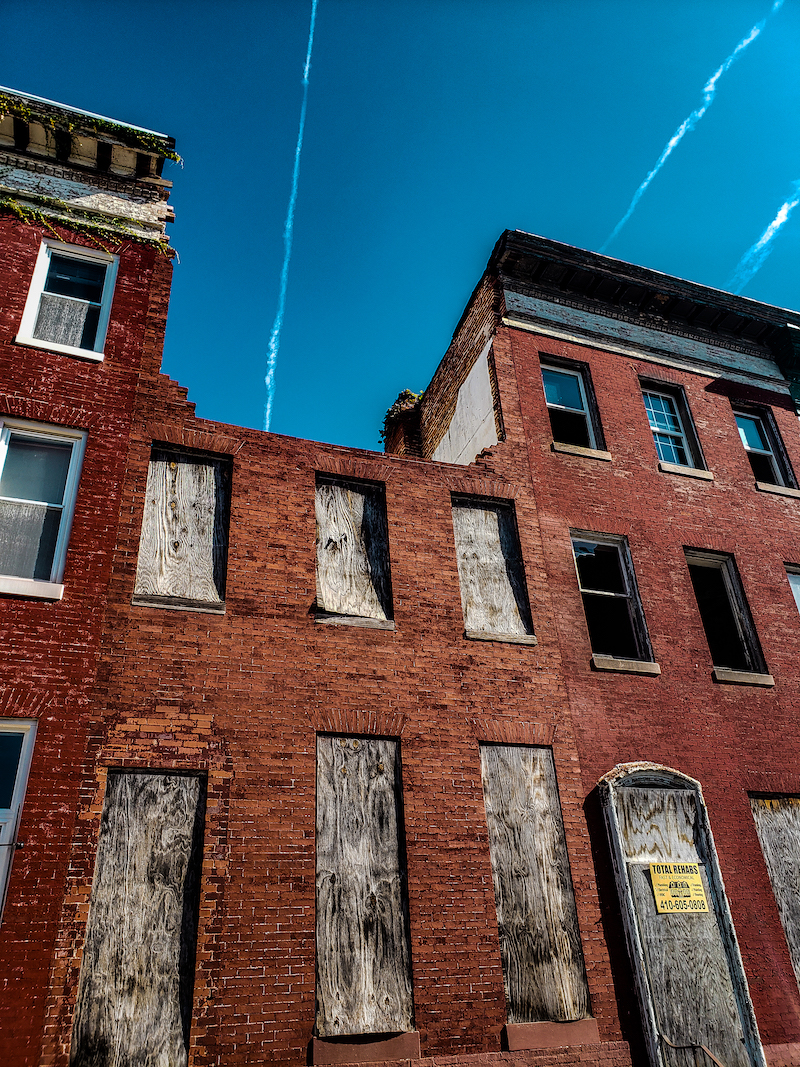One of the most powerful aspects of your introduction stated, “West Baltimore has aggressively opened my eyes to the irresponsibility and disservice of city officials done to urban Black communities. Ironically these communities once thrived and now they decay as new developments await.” Blight, redline, gentrification, and ruin are all defined for those who might be unfamiliar with the terms.
You mentioned that the first sign of gentrification that you saw in your neighborhood was the closing of all the corner stores close to your home. Although many argue that gentrification is not a bad thing, you stated that you disagree, saying that “gentrification is an aggressive tactic that is non-exclusive for minorities and for the poor.” Can you talk about what you meant when you made that statement?
I literally just moved from my neighborhood, my childhood neighborhood, in 2019. I was on Facebook one day and I was talking about gentrification and someone was like, “gentrification isn’t bad. Who would be against their neighborhood being fixed up?” Well, most of the time when neighborhoods are fixed up and changed and buildings are knocked down, you don’t see the people who used to be around there. And it’s slowly happening in my neighborhood. They built a new luxury apartment building and all the stores are gone. There’s nowhere to get food and stuff except for Hollins Market, which has gotten renovated and doesn’t have any of the stuff that it had before, except for a few stalls.
So it’s slow, it’s not like, “Hey, you gotta go right now.” But it’s like, “Eventually you got to go.” And you see that in a lot of neighborhoods in Baltimore. This area might be the projects or something for a long time, and then they just come and start overhauling and they give people vouchers to move out to the county.
Eventually, I feel like that’s what it’s going to be. It’s going to be Black, urban communities in the county and all the white people back in the city when they didn’t want to be in the city. It’s a confusing thing, but it’s definitely happening. Part of the reason that I wanted to do this book was to make people aware, especially residents in the neighborhood. When you’re in the midst of going through poverty, you are not [as] worried about what’s going on around you, you’re worried about keeping your family fed and housed and what you have to go through on a day-to-day basis.
So I think that people have an advantage when it comes to those neighborhoods, because it’s feeling like, “Oh, well, these people are not even paying attention, so let’s go and do what we gotta do for real. And they ain’t gonna know. They’re just gonna think they’re going on to somewhere better.”
And a lot of people do think that they’re “going off to the county to a nice house, but there’s no way for me to get back in the city.” They changed all the bus routes. So there’s no easy way to get in the city. There’s no easy way to get out. It’s a lot to that.
According to Dr. Lawrence T. Brown, racial equity consultant and author of The Black Butterfly: The Harmful Politics of Race & Space in America, the term Black Butterfly describes “the geographic clustering of where Black Baltimoreans live. The phrase denotes not only where Black Baltimoreans are geographically clustered but also where capital does not cluster and where structural disadvantages have accumulated due to the lack of capital access. (Penn North, Walbrook, Cherry Hill, Loch Raven, Waverly). The term White L is the description of the geographic clustering where white Balitmoreans live. The White L describes not only where white Baltimoreans live but also where access to capital is most readily available and the structural advantages incurred due to that capital access (Mount Washington, Greater Roland Park, Hampden, Remington, Charles Village, Fells Point, Little Italy).” How much of West Baltimore Ruins’ creation and design was inspired by Dr. Lawrence T. Brown’s research?
The part that is in there about the Black Butterfly, that was before I actually knew who he was. I was researching and trying to find information, because I first heard about it in college. When I was going to UB and I had community studies, my professor touched on that. And once I looked it up, I kept seeing his name. So I’m like, okay, who is this person? And then my professor told me who he was and how he coined that phrase, “the Black Butterfly.”
So I just went on to ask him about his research because I felt like it was very expansive and it was very important. At first, I paraphrased information that I found from articles about him and I was just like, “Why not go to the source?” So I went to the source and asked if I could include some information from him about the book directly. We talked and I’m really appreciative of him sharing that information, especially from his book. Y’all need to cop that, I’m copping that. That particular part of the book was inspired by him.
















